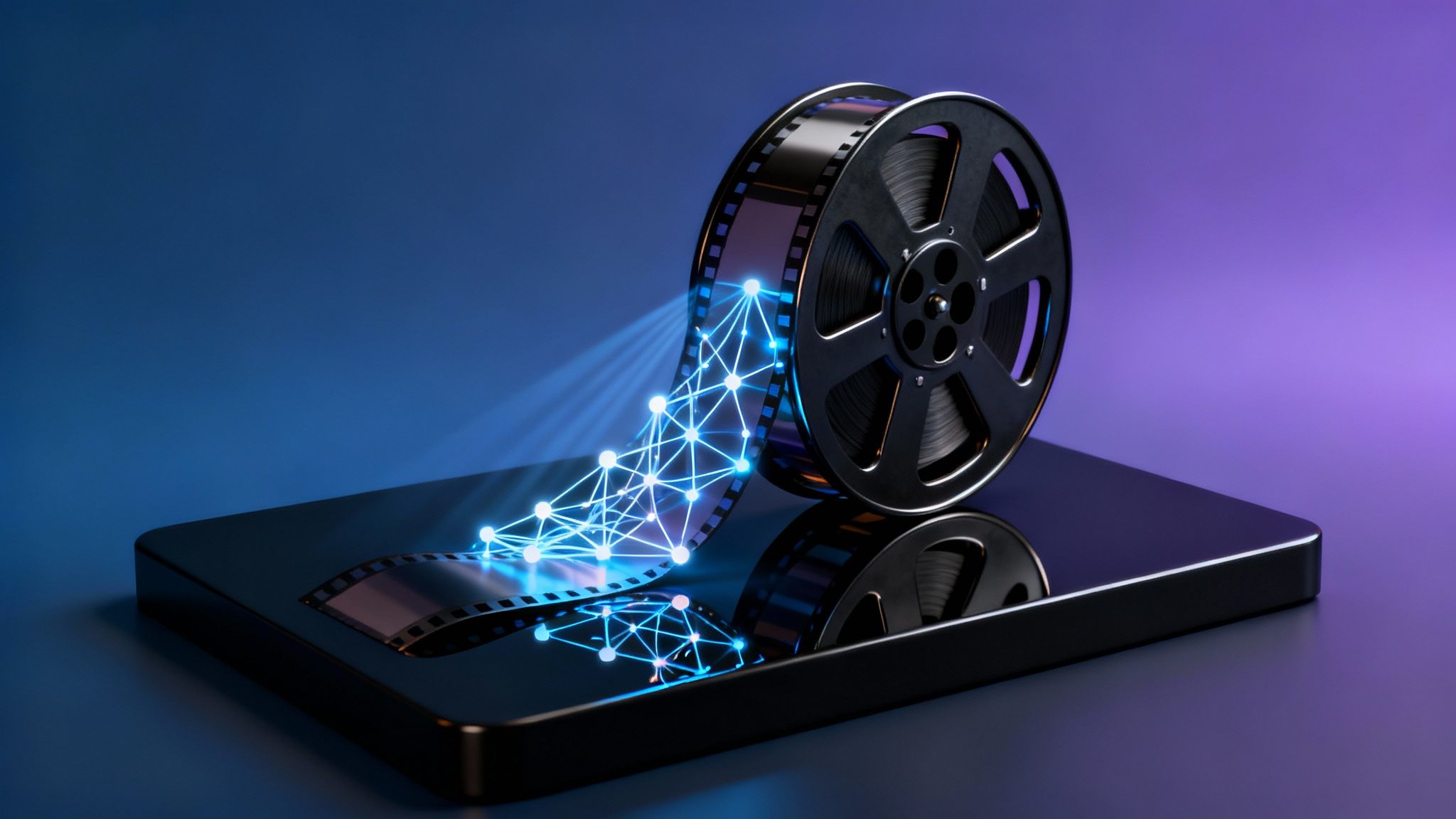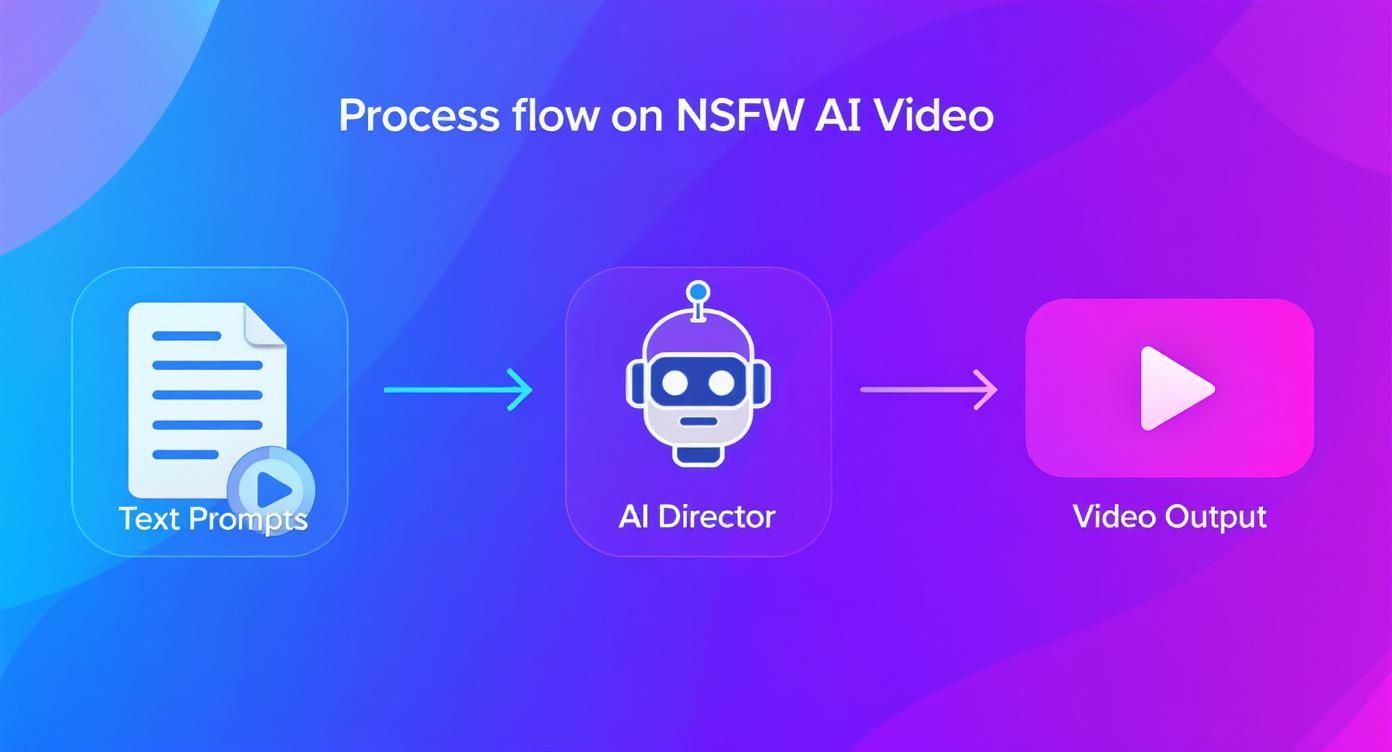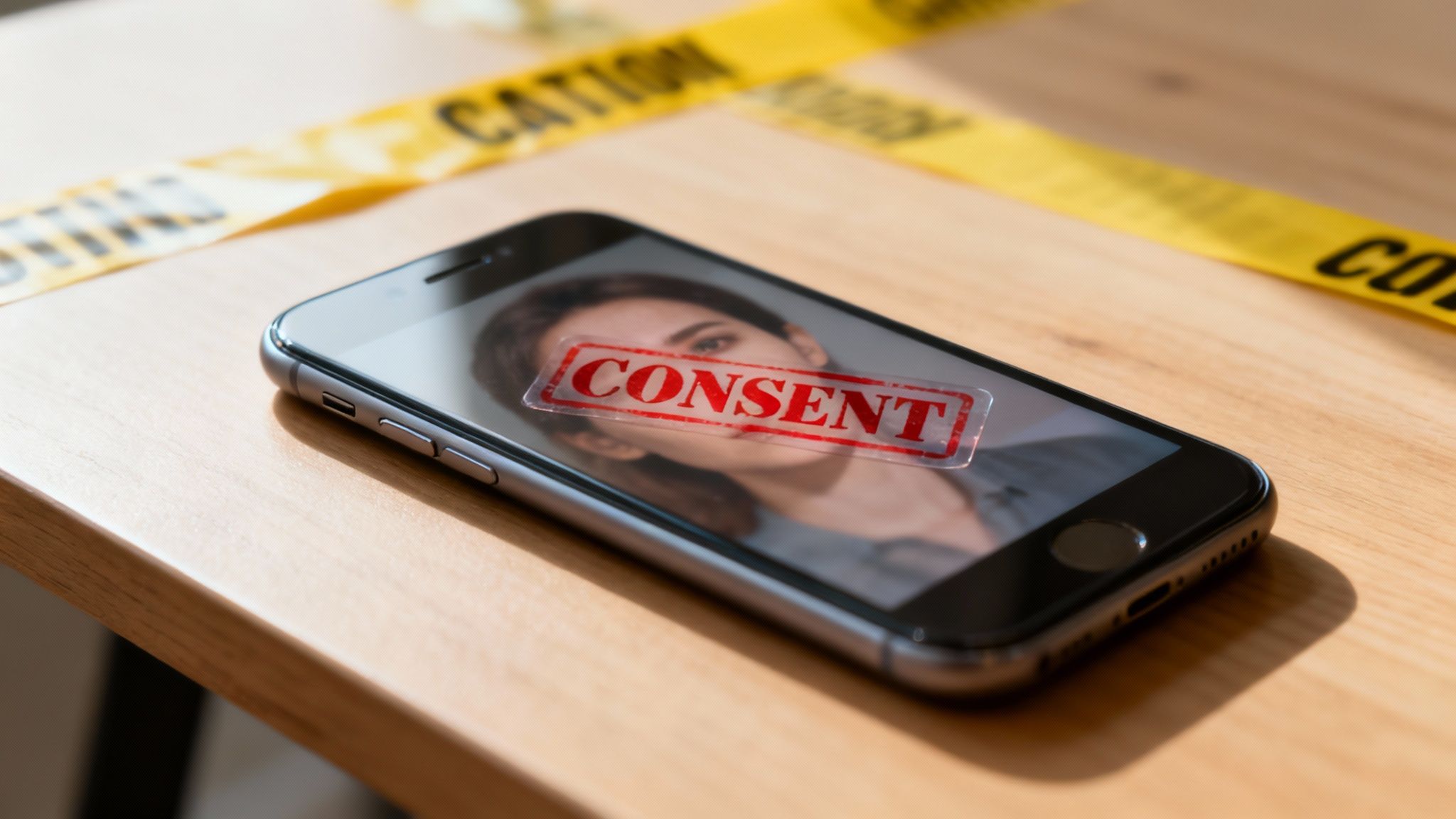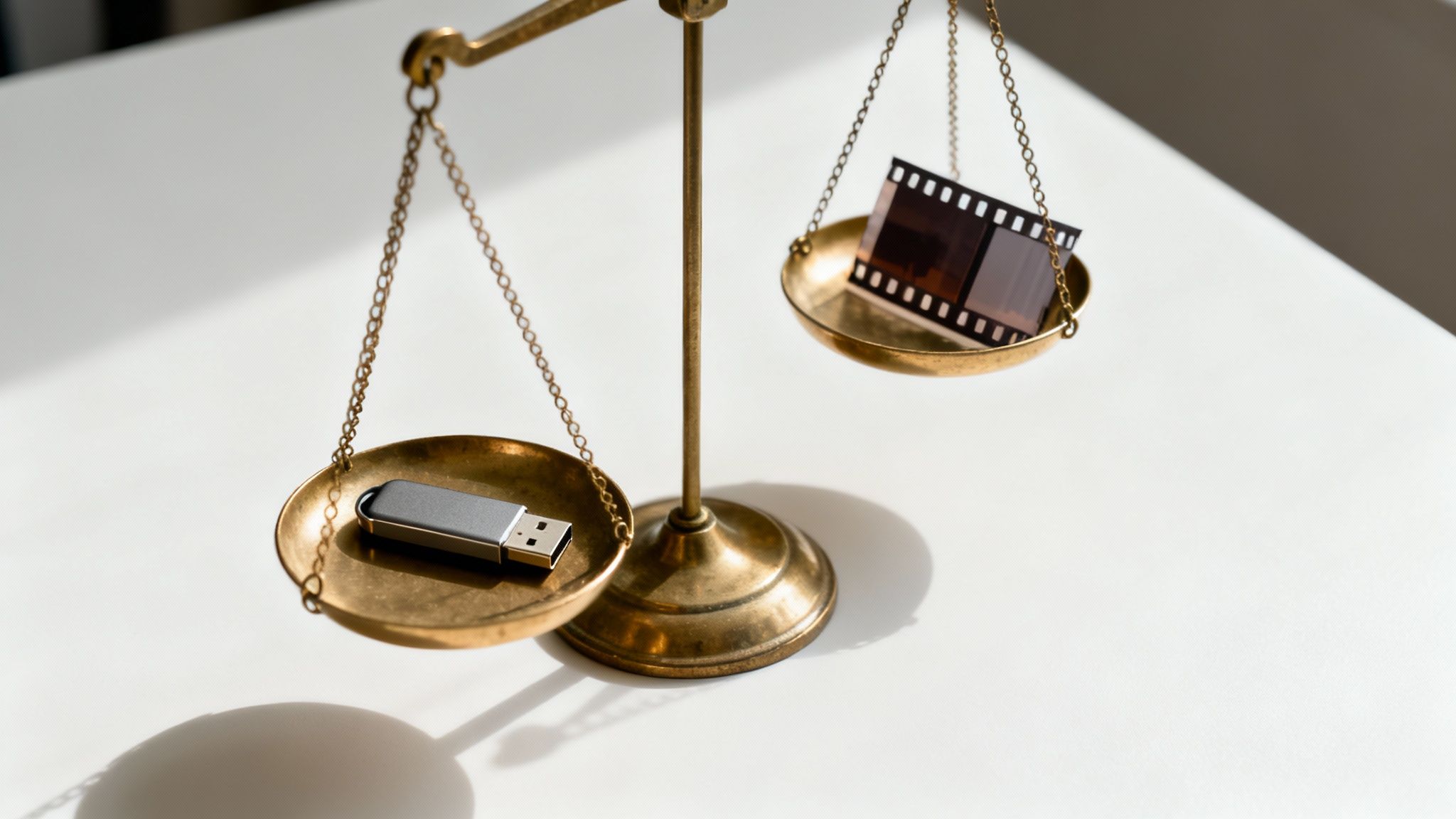Create Your Own AI Girlfriend 😈
Chat with AI Luvr's today or make your own! Receive images, audio messages, and much more! 🔥
4.5 stars

Ever wondered how you can turn a simple idea—a sentence, a thought, an image—into a full-blown adult video? That's the magic behind NSFW AI video generation. It's like having a personal film director on standby, ready to bring your most intimate or romantic fantasies to life with just a few clicks.
This technology gives you a level of creative freedom that was simply unimaginable a few years ago.
So, How Does This Actually Work?
At its heart, an NSFW AI video generator is a creative engine. You feed it a description—the characters, the setting, what they're doing—and it gets to work, translating your words into a moving clip. It's not just about slapping a few pictures together in a slideshow. The AI has to understand the context, keep the characters looking consistent from frame to frame, and create fluid, believable motion.
It’s a huge step up from the early days of AI image generators. Those tools could create a single, static adult picture. Now, these advanced platforms can take those characters and make them move, interact, and show emotion. The appeal is obvious: it offers a kind of personalization and privacy that traditional adult entertainment just can't touch.
What’s Behind the Surge in Popularity?
So why is this technology taking off? It really boils down to one thing: ultimate creative control. People are no longer just watching; they're creating. They can build stories and scenarios that perfectly match their own unique fantasies, exploring their interests in a completely private and non-judgmental way.
Driven by big leaps in AI and a real hunger for personalized adult content, the market for these tools has exploded. Platforms like LitVideo, CivitAI, and SoulGen are now packed with sophisticated features, letting you create videos from text or images in a ton of different art styles. This is all part of a bigger trend where AI tools have evolved from simple picture-makers to complex video producers. For a deeper dive into how this technology is evolving, explore our complete guide on NSFW AI and its applications.
The real game-changer isn't just making a video—it's making a personal video. It's the difference between watching a movie and directing one, giving you a powerful new way to explore your own imagination.
A Powerful Tool with Serious Responsibilities
Of course, with this kind of power comes a whole host of ethical questions and safety concerns. The ability to create realistic-looking videos of anyone raises the very real risk of misuse, especially when it comes to creating non-consensual deepfakes.
That's why any conversation about NSFW AI video has to include a serious look at consent, responsibility, and the guardrails needed to prevent harm. As we dig deeper, we'll keep this balance in mind—celebrating the incredible potential while staying clear-eyed about the risks.
The Technology Behind AI Video Creation
Ever wonder how a simple string of words can blossom into a full-blown video? It’s not quite magic, but it’s close. Creating an nsfw ai video isn’t a one-shot deal; it's more like an orchestra of sophisticated systems, all working together to turn a text prompt into moving pictures.
At the heart of it all are two main players: Generative Adversarial Networks (GANs) and diffusion models. These two technologies are the engines that power this creative process, but they work in very different ways.
The Artist and The Critic Method
Let’s start with GANs, which stands for Generative Adversarial Networks. The easiest way to think about a GAN is to picture a creative rivalry between an artist and an art critic.
The artist (called the "generator") churns out images based on your prompt, trying its best to create something believable. Meanwhile, the critic (the "discriminator") scrutinizes every single piece. The critic has been trained on millions of real-world images, so it has a sharp eye for fakes.
The critic's whole job is to call out the artist's mistakes. It sends back feedback, pointing out everything that looks off. This back-and-forth forces the artist to get better and better, until its creations are so good that the critic can’t tell them apart from the real thing. It’s this constant competition that drives the quality up.
This infographic breaks down how your idea gets from a text prompt to a finished video.

You can see how the AI essentially acts as a director, guiding the process from a raw concept into a dynamic, visual story.
Sculpting an Image from Digital Static
Now, where GANs are about a tug-of-war, diffusion models are more like sculpting. Imagine a block of marble. A diffusion model starts with the digital equivalent: a screen full of random, staticky noise.
From that chaos, the model slowly begins to chip away, guided by your text prompt. It refines the noise, step-by-step, until a clear and detailed image emerges. It’s an incredible process of bringing order out of digital randomness.
To make a video, the AI simply repeats this process, generating a sequence of these refined images. Each one becomes a single frame in your final clip, all strung together to create motion.
The Quest for Lifelike Consistency
Here’s the real kicker: making one great image is one thing, but making dozens per second that all flow together seamlessly is another challenge entirely. Early AI video models really struggled here. You’d get flickering, where a character’s face would subtly shift, or their outfit would change from one frame to the next.
This is where the latest breakthroughs have completely changed the game.
Today's advanced models have figured out how to maintain what we call "temporal consistency." They can lock onto a character’s identity—their face, hair, and clothing—and keep it stable across every single frame. This is absolutely crucial for creating a believable scene that you can get lost in.
The secret ingredient for a compelling NSFW AI video is consistency. Without it, the illusion shatters. Modern AI overcomes this by essentially "remembering" a character's features and applying them consistently from one moment to the next.
These improvements are nothing short of remarkable, especially when it comes to facial stability. Some of the best NSFW AI video generators now claim an ID consistency score as high as 0.96, which means characters look almost identical from one frame to the next. This level of realism is a huge deal for adult content, but it also brings up the constant tug-of-war between innovation and ethical responsibility, as some users will always try to push past safety filters on less secure tools.
Finding the Right NSFW AI Video Tools
Let's be honest, diving into the world of NSFW AI video generators can feel like trying to drink from a firehose. New platforms pop up constantly, all shouting about their unique features and mind-blowing quality. It's easy to get lost. Choosing the right tool isn’t just about finding one that works—it’s about finding the one that clicks with your creative vision, your comfort with technology, and your budget.
The field is wide open. You've got everything from simple, one-click text-to-video generators for total beginners to seriously complex platforms that give you god-like control over every pixel of a scene. Some tools are masters of hyper-realism, creating characters so lifelike they're almost uncanny. Others are all about stylized animation, perfect for bringing different fantasies to life. The right choice for you depends entirely on what you're trying to create.
So, what’s your goal? Are you looking for a quick and dirty way to churn out some wild, imaginative clips with zero fuss? Or are you a hands-on creator who wants to play director, tweaking every camera angle, pose, and facial expression? Figuring that out is the first real step to cutting through the noise.
Comparing Generator Styles and Features
Let's get into the nitty-gritty. The biggest difference between platforms usually boils down to a classic trade-off: ease of use versus creative control. A simple generator might just ask for a text prompt and spit out a video in a few minutes. That's fantastic for casual experiments and seeing what's possible.
On the other end of the spectrum, you have advanced tools that are more like a virtual film set. These platforms let you obsess over the little details that make a huge difference in the final cut.
Here are the key differentiators to keep an eye on:
- Input Method: Is it all about the text prompt, or can you upload a reference image to create a specific character? Image-to-video generators give you a much more personal touch.
- Artistic Style: Is the platform a one-trick pony, stuck on photorealism? Or does it have a whole library of styles, from anime to painterly?
- Control Granularity: Can you dictate camera pans, adjust the lighting, and command specific expressions? Or are you leaving those creative choices up to the AI?
- Consistency Engine: This one is huge. How well does the tool keep your character looking the same across different scenes? High consistency is the secret sauce for telling a believable story.
These features directly shape the kind of nsfw ai video content you can bring to life. For example, a generator with a weak consistency engine might be fine for short, one-off clips, but it's going to fall flat if you're trying to create a series with a recurring character.
What to Prioritize in a Platform
Beyond the shiny creative tools, the practical stuff matters just as much. Things like the user interface (UI), processing speed, and how you pay for it are critical. A clunky, confusing interface is a creativity killer, and watching a render bar crawl for ages is just plain frustrating.
Most platforms run on either a subscription or a credit-based system. A subscription might give you unlimited runs, while credits mean you only pay for what you generate. Think about how much you'll be creating—if you're going to be a power user, a subscription is probably the smarter buy.
The best tool for you is the one that feels intuitive. It should feel like it's helping you create, not fighting you every step of the way. A free trial is your best friend here. Use it to test the workflow, judge the output quality, and see if the platform’s vibe matches yours before you pull out your wallet.
Ultimately, you want a platform that can grow with you. Maybe today you're happy with simple text prompts, but tomorrow you might want to dive into complex animations. For creators who want to build characters from the ground up, advanced tools like the Luvr AI character builder offer a powerful way to design totally unique personas for your projects.
Making an Informed Decision
To help you choose, it's worth taking a moment to look at the different types of platforms out there and see where they shine. Below is a quick comparison of the leading generators to give you a clearer picture of your options.
Comparison of Leading NSFW AI Video Generators
This table compares some of the most popular NSFW AI video generation platforms, breaking down their key features, typical output quality, and how they handle safety and privacy. Use it to find a tool that aligns with your creative goals and comfort level.
| Platform Name | Primary Feature | Output Style | Ease of Use | Safety & Privacy Score (1-5) |
|---|---|---|---|---|
| Luvr AI | Character Consistency & Customization | Hyper-Realistic, Stylized | Intermediate | 5 |
| Unreal Person | Speed & Simplicity | Realistic, Animated | Beginner | 4 |
| Soulgen AI | Anime & Fantasy Styles | Highly Stylized, Anime | Beginner | 3 |
| PornPen AI | Text-to-Video & Image-to-Video | Photorealistic | Intermediate | 4 |
Each platform has its own flavor. Some are built for speed and simplicity, while others, like Luvr AI, focus heavily on giving you the controls to maintain character consistency—a must-have for storytelling. By weighing these factors against what you want to achieve, you can look past the marketing hype and pick a generator that truly fits your needs. This way, your journey into creating nsfw ai video content will be a lot more fun and creatively satisfying.
Confronting the Ethical Minefield

There's no denying the raw power of NSFW AI video technology. But with great power comes a moral responsibility we absolutely cannot sidestep. This conversation goes way beyond creative expression or cool tech. It's about real people, consent, and the very tangible risk of these tools being weaponized to cause deep, lasting harm.
When the lines between real and synthetic get this blurry, the fallout can be devastating. We're stepping into a world where anyone's likeness can be digitally hijacked and dropped into any scenario you can dream up, often without them ever knowing. This isn't some far-off, sci-fi problem—it's happening right now.
The Human Cost of Non-Consensual Content
At the heart of this ethical storm is one simple, crucial word: consent. The ability to deepfake a real person into an explicit video is a profound violation of their autonomy and privacy. Let's be clear: this isn't a victimless act of creation. It's a form of digital assault.
The psychological toll on people who find their image used this way can be catastrophic. Victims often describe intense feelings of shame, anxiety, and helplessness—a sense that a piece of their identity has been stolen and twisted. It can shatter reputations, destroy relationships, and inflict severe emotional trauma.
Looking beyond the individual, this practice corrodes trust on a societal scale. If any video could be a fake, how can we ever believe what we see? This erosion of trust has massive implications, not just for our personal lives but for public discourse itself.
The Double-Edged Sword of Realism
The very technological leaps we admire—the hyper-realism and flawless consistency—are exactly what make this so dangerous. The more convincing an NSFW AI video is, the more potent it becomes as a weapon. A crudely made fake is easy to laugh off, but a seamless, lifelike video is a perfect tool for:
- Harassment and Bullying: Targeting people with fabricated videos to humiliate or intimidate them.
- Revenge Porn: Creating non-consensual explicit content of ex-partners as a vicious form of retaliation.
- Defamation: Wrecking someone's public image or career with fake "evidence" of misconduct.
These aren't just hypothetical what-ifs. Cases of AI-driven abuse are already making headlines, forcing a tough conversation about who is accountable. Is it the developers building the tools, the platforms hosting the content, or the individuals hitting "generate"? The uncomfortable answer is probably all three.
"The central question is not what the technology can do, but what it should do. Without a strong ethical framework grounded in consent, we risk normalizing a new and insidious form of abuse."
The Creator's Moral Compass
If you're using these tools, you're not a passive observer in this. You're in the driver's seat. Every time you generate a video, you're making an ethical call. The temptation to use a celebrity's face or even a private individual's likeness might seem harmless, but it feeds a culture where consent is treated as an afterthought.
The only responsible way forward is to adopt a strict personal code of conduct. This means never using a real person's likeness without their explicit, enthusiastic permission. Period. It means channeling your creativity into crafting entirely fictional characters and exploring fantasies that exist purely in your imagination, where no one gets hurt.
This technology puts an incredible tool in your hands. Wielding it with integrity isn't just a friendly suggestion—it's a moral imperative. The future of AI-generated media hinges on the choices we all make today. Let's choose to build a creative space that's not only exciting and innovative but also safe, respectful, and fundamentally human.
Understanding the Legal Risks

Once you step outside the ethical maze, you land squarely in a minefield of real-world legal consequences. Creating and sharing an nsfw ai video doesn't happen in a vacuum. If you ignore the legal framework, you're not just being risky—you're walking a direct path to serious trouble for yourself and any platform you use.
The law is definitely playing catch-up with the tech, but let's be clear: accountability is coming. From copyright claims to defamation lawsuits, the potential for legal blowback is massive.
The Content Moderation Nightmare
For any platform hosting user-generated content, this is a whole new level of chaos. The sheer volume of AI-generated media flooding the internet is staggering, and trying to review it all manually is a complete fantasy. This reality has forced a heavy reliance on AI-powered moderation systems just to keep illegal or harmful content from spreading like wildfire.
To give you a sense of scale, we're talking about over 3.2 trillion images and videos shared online in a single year. Combine that with an AI generator market projected to rocket to $1.08 billion by 2030, and you’ve got a perfect storm for legal exposure. Platforms are now in a bizarre arms race, using sophisticated AI to police other AI, with tools automatically flagging explicit material to stay compliant with laws like the EU's Digital Services Act (DSA).
Navigating Copyright and Defamation
Two of the biggest legal traps you can fall into with nsfw ai video are copyright infringement and defamation. Let's get specific.
- Copyright Infringement: Did you train your AI model on copyrighted images? Did you use a character that belongs to a major studio without getting permission? That's a lawsuit waiting to happen. Artists and companies are fiercely protecting their intellectual property.
- Defamation: If you create a video that falsely shows a real person in a damaging or explicit light, you're opening the door to a defamation claim. The more realistic that video looks, the stronger the legal case against you becomes.
These aren't just theoretical problems. Precedents are being set in courtrooms right now, and judges are not looking kindly on digital impersonation or the theft of someone's likeness.
Ignoring the legal framework is not an option. Responsible innovation demands compliance, and understanding these rules is the first, most critical step to using this technology safely and protecting yourself from severe penalties.
The Rise of Stricter Regulations
Governments around the globe are finally waking up to the potential for this technology to be misused. The European Union is out in front with its Digital Services Act (DSA), which puts heavy obligations on platforms to get a handle on illegal content, including non-consensual deepfakes. You can bet that similar laws are being hammered out in the United States and elsewhere.
This all means that pleading ignorance won't get you very far. As a creator, you're on the hook for what you make. For platforms, having clear, enforceable terms of service is a matter of survival. To see how companies are adapting, it’s worth reviewing their 2257 statements and legal frameworks, which show how they're navigating these complex rules.
The bottom line? The legal tide is turning, and it's pulling everyone toward greater accountability.
The Future of AI-Generated Content
https://www.youtube.com/embed/m-Wbn1htwdY
The road ahead for AI-generated media is looking wild, pointing toward a future that feels both incredibly exciting and more than a little nerve-wracking. We're blowing past simple text-to-video clips and heading straight for real-time, interactive experiences and hyper-realistic content that’s almost impossible to tell from reality. The rapid evolution of nsfw ai video is a perfect example of this acceleration, showing us just how fast these creative engines are learning.
But this journey brings us to a major crossroads. The very same tech that offers mind-blowing creative freedom can cause real, significant harm if it falls into the wrong hands or is used recklessly. The future isn't just about what the technology can do, but what we—the community of creators, developers, and users—decide it should do.
This isn't just some abstract thought experiment; it's an urgent call to action. The decisions we all make today will have a ripple effect, shaping the social and ethical rules of the road for years to come.
Building a Framework for Responsible Innovation
To move forward, we need to get on the same page. We’ve seen the sheer power of this technology, wrestled with the thorny ethical questions, and started to map out the legal minefields. Now, it's time to weave these separate threads together into a solid framework for responsible innovation.
This means building safety features directly into the tools we’re creating and using. It’s on developers to prioritize consent and user safety, even if it means putting a cap on certain capabilities. For creators, it means adopting a personal code of conduct—a promise to use these tools for imagination and exploration, not exploitation.
The real measure of this technology's success won't be how realistic it is or how fast it runs. It will be our ability to blend its power into our world in a way that respects human dignity and protects those who are vulnerable.
The Creator's Role in Shaping Tomorrow
Your part in this is bigger than you probably realize. Every time you create an nsfw ai video, you’re casting a vote for the kind of future you want to live in. By choosing to build original, fictional characters and steering clear of using the likeness of real people without permission, you help build a culture of ethical creativity.
Here’s how we can collectively steer this ship in the right direction:
- Champion Consent: We need to make creating non-consensual content both socially unacceptable and technically difficult.
- Support Ethical Platforms: Give your business to services that have clear safety policies and aren't afraid to enforce them.
- Educate Others: Don't keep what you know to yourself. Share your knowledge about the risks and push for responsible use within your own creative circles.
The conversation about AI-generated content is no longer a geeky, niche debate. It's a fundamental discussion about our shared digital future. We are standing at the dawn of a new creative age, with tools of unbelievable potential in our hands. Let’s make a commitment to building a future where innovation and integrity don't just coexist—they're one and the same.
Frequently Asked Questions
It’s natural to have questions when you’re exploring NSFW AI video. The technology is new, the rules are still being written, and it's smart to tread carefully. Let's clear up some of the most common concerns so you can create with confidence.
Is It Legal to Create NSFW AI Video?
This is a real minefield, and the answer completely depends on your location and what you’re making. Generally, creating videos of purely fictional characters for your own private use tends to exist in a legal gray area. But that all changes the second a real person's face enters the picture.
Using someone's likeness—whether they're a celebrity or a private citizen—without their clear, upfront consent is illegal in many places. It can open you up to serious trouble, from civil lawsuits to criminal charges. And it goes without saying, but any content involving or appearing to involve minors is absolutely illegal and prosecuted harshly. Always check your local laws before you even think about starting.
What Are the Dangers of Free NSFW AI Tools?
The word "free" is tempting, but when it comes to free NSFW AI tools, it often comes with a steep, hidden price: your security. A lot of these platforms are built on shaky foundations, making them perfect gateways for malware, spyware, and phishing attacks designed to snatch your personal and financial info.
They also tend to have flimsy (or nonexistent) privacy policies. This could mean your prompts, the images you generate, and your personal data are being collected, shared, or sold without you ever knowing. On top of that, they rarely have the sophisticated safety filters of paid services, which puts you at risk of accidentally creating something illegal or harmful.
The biggest risk with free tools is the total lack of accountability. When you aren't paying for the product, you and your data become the product. Reputable platforms invest heavily in security because their entire business model relies on keeping you safe.
How Can I Use This Technology Ethically?
Using this tech ethically really comes down to a single, powerful idea: consent. The only responsible way to create is to make absolutely sure your work isn't hurting a real person.
Here’s a simple code of conduct to live by:
- Never use a real person’s likeness without their direct and enthusiastic permission. No exceptions.
- Keep your creativity focused on generating completely fictional characters and scenarios.
- Throw your support behind platforms that have clear, firm policies against non-consensual content and deepfakes.
The bottom line is easy to remember. If what you're creating could be used to exploit, humiliate, or harm a real person, you've stepped over a major ethical boundary.
Will AI Replace Human Adult Content Creators?
A complete takeover is pretty doubtful. AI can produce some stunning visuals, but it can't fake genuine emotion, spontaneous moments, or the kind of authentic connection that people crave. A huge part of the adult entertainment audience is there for the human element—the interaction and personality that a machine just can’t mimic.
What's far more likely is that AI will become just another tool in the creator's toolkit, not a replacement for them. It’ll probably be used to craft custom animations, explore wild fantasy scenarios, or serve niche interests that complement what human performers do. The market will likely just split, with some audiences preferring human-driven content and others gravitating toward AI, depending on what they're looking for.
Ready to start creating with an AI that puts safety, control, and your experience first? See what's possible with Luvr AI and design your perfect AI companion today. Discover more at https://www.luvr.ai.



